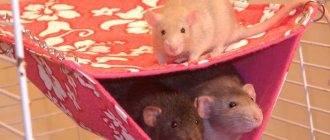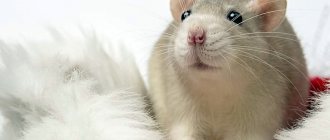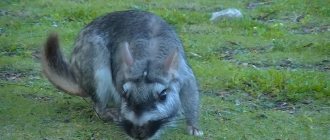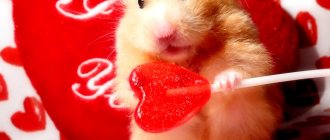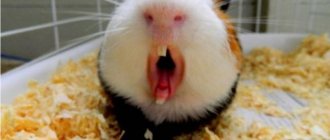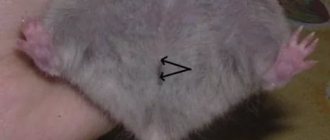- home
- Rat
- Purchase
09/05/2019 Rats are very smart animals. Today they are often found as pets. Unfortunately, the life expectancy of the animals is short. Therefore, many are interested in the question of how to determine the age of a rat. Thanks to this, it will be possible to purchase a young animal. It is recommended to get a one and a half month old pet.
Lifespan
Experts say: the average age of a decorative rat is 1.5-2 years. With good care and the absence of pathologies, individuals can live up to 4 years. But if an animal survives its 4th birthday, then this is considered a unique case in nature. Therefore, the owners’ claims that their pets lived to the age of five are very doubtful. Moreover, there are no officially registered animals at this age.
The lifespan of pets is influenced by their living conditions. Rats experience stress from the noise of household appliances, and they are negatively affected by cigarette smoke. The main factors that reduce the life expectancy of animals are improper feeding and lack of attention to the pet.
What factors does it depend on?
Experienced breeders know how long rats will live at home - this largely depends on the pedigree of the animals. In other words, the lifespan of a house mouse is directly related to genetics.
If parents are sick, they will not have healthy children. Weak children are also born from close relatives. These children live short lives and often get sick. Only healthy animals with the desired coat pattern and color are selected for crossing.
Accordingly, in order for pet rats to please their owners for a long time, it is advisable to purchase them in kindergartens, where specialists monitor the reproduction and treatment of their charges.
In addition to the child’s pedigree, future nursery owners will be told how to care for them, what they can and should be fed, what vaccinations they received and what needs to be done.
A healthy and rich diet for your pet will also ensure a long and happy life. Human food and junk food can cause illness and premature death in an animal.
Do not spoil your pet with chips, sweets and other similar treats.
The living conditions of pets are very important, so it is necessary to provide rats with everything they need.
Comparison with human age
Rats grow very quickly. It is believed that at one and a half months the cubs already reach maturity. The child's body is formed before this period of approximately 12.5 years.
The period of social maturation in rats, which is characterized by complete independence, ends at six months. By human standards, this is comparable to a child reaching adulthood.
A rat's age of 1 year is approximately 30 years in human years. In the future, each month of a pet’s life can be roughly equated to 2.5 years. For example, a three-year-old pet reaches the age of 90 years by human standards.
Attention! Menopause in females occurs at 15-18 months, which corresponds to a human age of 48-55 years. This means that offspring no longer appear after this period.
How to extend the life of a pet?
The lifespan of a decorative rat largely depends on nutrition. The following expert tips will help you create the right diet for your pet:
- It is unacceptable to feed rats in large portions - this can lead to obesity and rapid death of the animal.
- Food for pet mice should be rich in antioxidants: the presence of free radicals in the body contributes to the development of diseases and accelerates the aging process.
- When purchasing food, you should only choose food that is specifically made for mice.
Another important factor is care and attention. Rats do not like high temperatures or cold, so it is necessary to install a house for them in a warm, dry room, without drafts, but away from radiators or heating devices. The house itself should be large enough to allow its occupant enough space to move around.
If the TV is often on in the room or people listen to music, it is better to move the rat house to another warm but quiet room. Rats do not like the frequent presence of strangers or animals.
Communication is no less important for mice: in nature, rodents live in groups, so they have difficulty withstanding loneliness. It is better to buy not just one pet, but two or three, so that they can communicate not only with people, but also with their fellow creatures.
Growth rate
Changes in little rat pups are observed daily:
- On the 3rd day the ears appear.
- Teeth appear on days 8-10.
- After 2 weeks, the nipples of females become visible.
- In the third week, the eyes open and the body becomes covered with fur.
The period of childhood in animals is very short, which is confirmed by the following:
- Within 10 days, the pups grow to the size of an adult mouse.
- After a little more than three weeks, the animals begin to feed on their own.
- After 30 days, the cubs leave the parental nest.
Subsequently, the rats grow until the age of 6 months. After this, they gradually mature and reach their maximum size at about a year.
Little rats. Development and rearing of rat pups
1 period
Rats are born naked, blind, with closed ears, undeveloped limbs and a short tail. Body weight ranges from 4.0 to 6.5 g. They are helpless. All that baby rats can do during the first hours of life is suck. But they suck actively and grow quickly. The weight of a newborn animal reaches 3-6 g, depending on the number of individuals in the litter. Rat cubs grow and develop somewhat slower than hamsters. During the first days, the cubs cannot be handled; they can only be examined visually. Newborn rat pups feed on mother's milk, which contains 8.7% protein, 9.3% fat and 3.7% lactose (in human milk the protein content is 1.6%, fat - 3.3%, lactose - 6, 8%).
Article on the topic: How much does a guinea pig cost in a pet store, nursery and market
2nd period
Newborns' ears open on the third or fourth day after birth. On the fourth to sixth day, they develop a soft coat. On days 8-10, rat pups begin to teethe. By 10 days of age, the cubs' lower incisors have erupted. Molars appear later, 19-40 days after birth.
3rd period
Eye opening occurs on the 14th-17th day. To establish sex and examine the cubs at the end of the second week, they can be removed from the nest for a short time in the absence of the female. At this time, sex can only be determined by the presence of nipples in females, because the testicles of males still lie in the abdominal cavity and are not visible. Cubs are most active at the age of 8-20 days, but at this time great care is required in handling them, since their actions are not yet fully coordinated and they may fall to the floor. By day 16, the pups are completely covered with hair. In the second week of life, newborn females develop breast nipples. They are absent in newborns.
4th period
By day 21, the pups leave the nest and begin to eat food from the feeder. At the age of 25-28 days, the rat pups are placed in separate cages. Young rats require not only their mother's milk, but also contact with their mother, which gives them experience, security and warmth. Young rats that are sold too early remain small and get sick more quickly. It is possible to separate cubs from their mother at an age when they have reached, for example, the size of a large house mouse.
The growth of rats, which lasts 11-12 months, is influenced by many factors, but the main one, of course, is nutrition, which should be mixed and varied. Feeding young animals follows the same principle as adults, but fresh greens, sprouted wheat grains, fish oil and animal feed should be added to the diet. To create friendly relations with baby rats, you need to pick them up more often in the absence of the female, starting from a very early age.
Article on the topic: How to choose a guinea pig: choosing between a boy and a girl, breed
Thus, within three weeks, animals ready for independent life grow from defenseless naked lumps. The intensive growth of rat pups requires careful adherence to the feeding and maintenance standards of their mothers. During the suckling period, females should receive plenty of fluids and adequate feeding with sufficient protein, mineral salts and vitamins. Rats, as well as other small rodents, are characterized by different growth of individual parts of the body. The limbs and ears finish growing first - by the time they leave the nest they reach the sizes characteristic of adult animals. The tail takes a little longer to grow. By one and a half months, the weight indicators of the internal organs and brain have stabilized. By this time, the reproductive organs of females and males are finally formed, and already at the age of 5-7 weeks a young female can become pregnant, which is extremely undesirable for such a young creature.
The growth of rodents is greatly influenced by the level of feeding. With severe protein starvation, rat pups grow more slowly and mortality increases. Such animals give poor offspring in the future. Clean water should always be in drinking bowls - lack of drinking for a long time negatively affects the health of animals and their offspring. Young rodents need more food. With an animal weighing 10-14 g, the amount of food it eats per day is on average 70-80% of its body weight, and in some cases it can reach 100% or more. With age, young animals gain weight, and their need for feed changes accordingly.
Healthy foods
for baby rats 1-3 months: Cottage cheese, boiled chicken bones, boiled fish, apples, bananas, milky corn.
Should be limited
: broccoli, lettuce, boiled liver, yeast, egg yolk.
Harmful products
: champignons, tomatoes, cucumbers
Distinctive features of a young rat
To approximate the age of a rat, you need to weigh it. At the same time, the weight of the male and female is different. When purchasing a pet, you can approximately determine its age, taking into account fixed weight parameters. For the female they are:
- At 2 months 150-200 g.
- At 3 months 210-250 g.
- At 4 months 260-290 g.
- At 5 months 300-340 g.
When choosing a male, the basic weight indicators change upward:
- At 2 months 160-220 g.
- At 3 months 230-310 g.
- At 4 months 320-410 g.
- At 5 months 420-490 g.
Posts 1 page 4 of 4
Share12012-04-26 18:56:09
- Author: Krisik 888
- Moderator
- From: Moscow
- Registered: 2012-04-08
- Invitations: 0
- Posts: 117
- Respect: +9
- Positive: 0
- Female gender
- Age: 35 [1984-04-05]
- Time spent on the forum: 14 hours 43 minutes
- Last visit: 2013-06-08 23:26:47
- Pets: Rats with a litter, soon I will be able to sell the cubs to whoever needs them
- From: Moscow
The sex of a rat is most easily determined by its tail, and its age by its teeth. Rodents of different ages have different colored teeth, and different tail fluffiness and also a different color.
Floor
The surest way is that in males the testicles (or testes) are clearly visible under the tail, and in females the nipples are clearly visible. At the age of up to 4 weeks, it may be impossible even for an expert to determine the baby’s age. The tail of a young male is white or orange-pink in color, with a uniform coat of hair, including the “bare” part of the tail. Or there may be lighter pink circles on the tail. But it’s pink, never white. The tail of a young female is usually a little bushier with white circles. It can also be almost completely white, off-white or beige. It is important that the pattern on the tail is clearly white. In males the tail is a richer pink color, in females it turns white. By six months, the male's tail becomes a rich orange/dark pink color. By about 7-8 months, the female’s tail is often covered with brown transverse stripes. Males of variegated colors even have a spotted tail.
Age
It is impossible to accurately determine the age of the rat. There are some indicators based on which you can determine the age of a rodent up to a year, and then approximately. After a year, you can only tell that the rodent is more than a year old - by its bright, dark-dark-dark orange, or even red, teeth. Plus they have a more mature character than children.
1. Very small rodents of dark or variegated colors usually have pink teeth. This is a rat up to 2 months maximum. 2. Baby rats of the Rex and Fuzz breeds up to 3-3.5 months old have a so-called “cap” - a half-naked place on the head or face. Adult molted rodents of the same breeds have more naked and half-naked places on their bodies. Not all babies of these breeds have a hat. 3. Young rats have completely black eyes, the iris is not visible. The iris gradually brightens, and by 5-8 months (sometimes by a year), a white rim appears around the eye. 4. The fifth toes on the rat’s front paws can be a very relative indicator. Before the first molt (up to 3-3.5 months), they are small or absent at all. After molting they become larger. 5. In females, the tail acquires brown transverse stripes by 7-9 months; in males, the tail becomes orange by six months of age.
Differences between old individuals
After six months, difficulties arise in determining the age of the animal during the weighing process. To do this, you need to take into account various external characteristics. You should pay attention to the length of the animal’s tail. If it is equal to the length of the body, then the animal is definitely more than a year old.
In addition, the following signs indicate maturity:
- Dull and sparse fur, sticking out in some places.
- Rough skin on the tail with a large number of keratinized flaking areas.
- A hunched body, indicating the absence of a fatty layer on the back, which is always present in young individuals.
- Long incisors with ground back.
Harm to humans
Many people are wary of rats. And for good reason, because they can cause a lot of harm and trouble.
Wild rats
Gray rat: dangerous neighbor.
Rats cause great harm when they get into food storage areas. They can damage various structures, devices, and insulation of electrical cables. They sneak into houses and live in trash cans.
Animals are carriers of various dangerous infectious diseases, such as plague, rabies and several types of encephalitis.
Often wild species of rats come to vegetable gardens and garden plots in search of food. They spoil people's supplies and make their own from grains and root crops. In times of hunger, they eat the bark and roots of trees.
Decorative rats
Decorative rat.
We must remember that rats are rodents, and if an animal living in an apartment is allowed to roam indoors, it can damage the cable, chew documents, and damage furniture. Even during a walk, it is important to monitor the rodent so that it does not cause harm.
Rats can mark their territory with their scent; it is also worth walking them under supervision so that there are no surprises.
We recommend reading: interesting facts about rats. You definitely didn’t know that.

